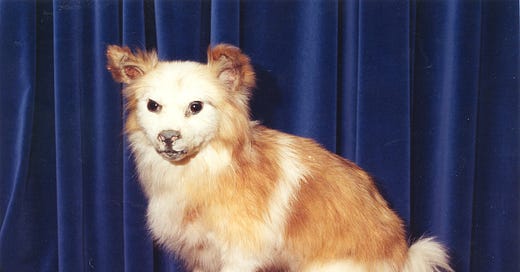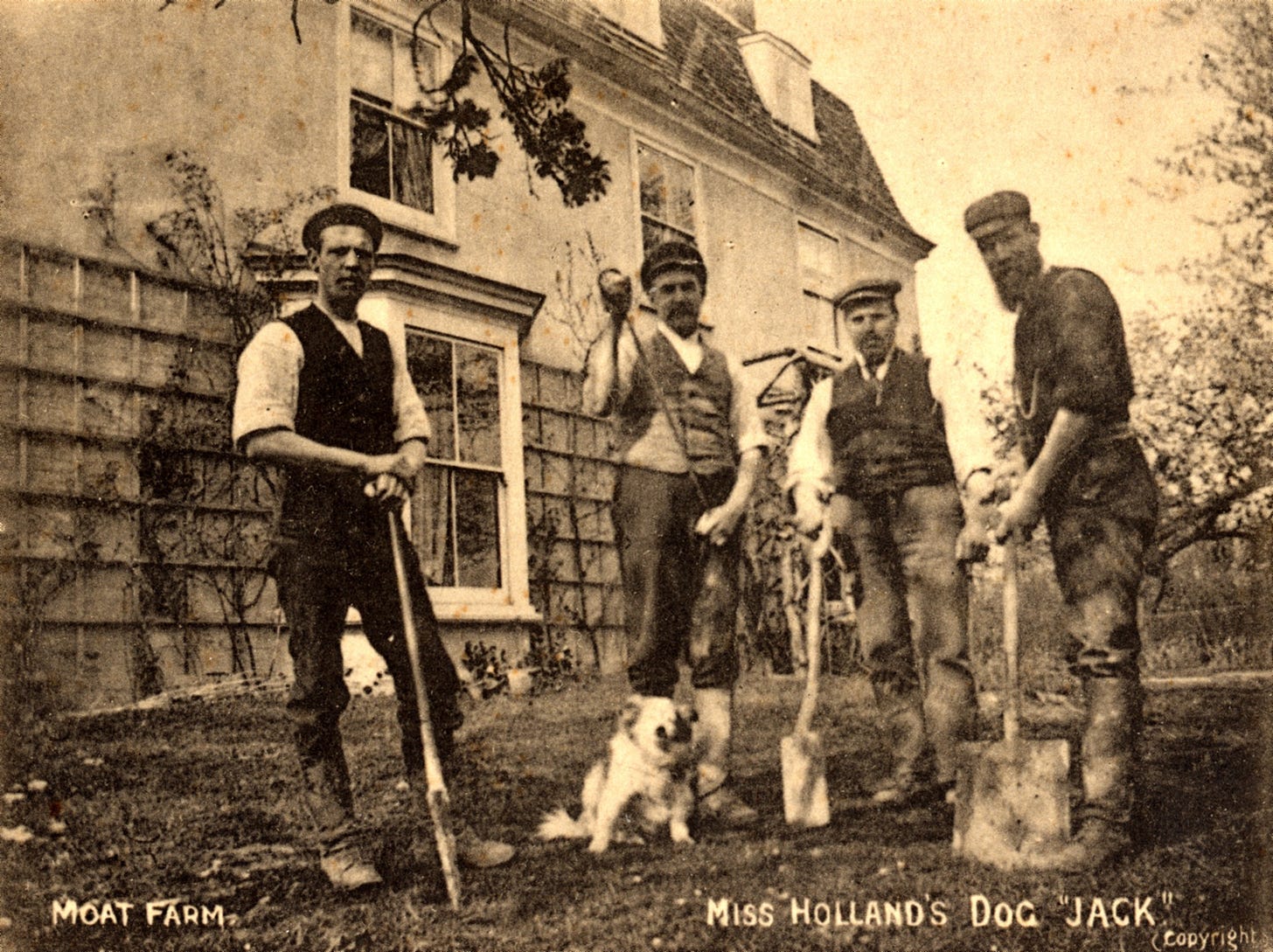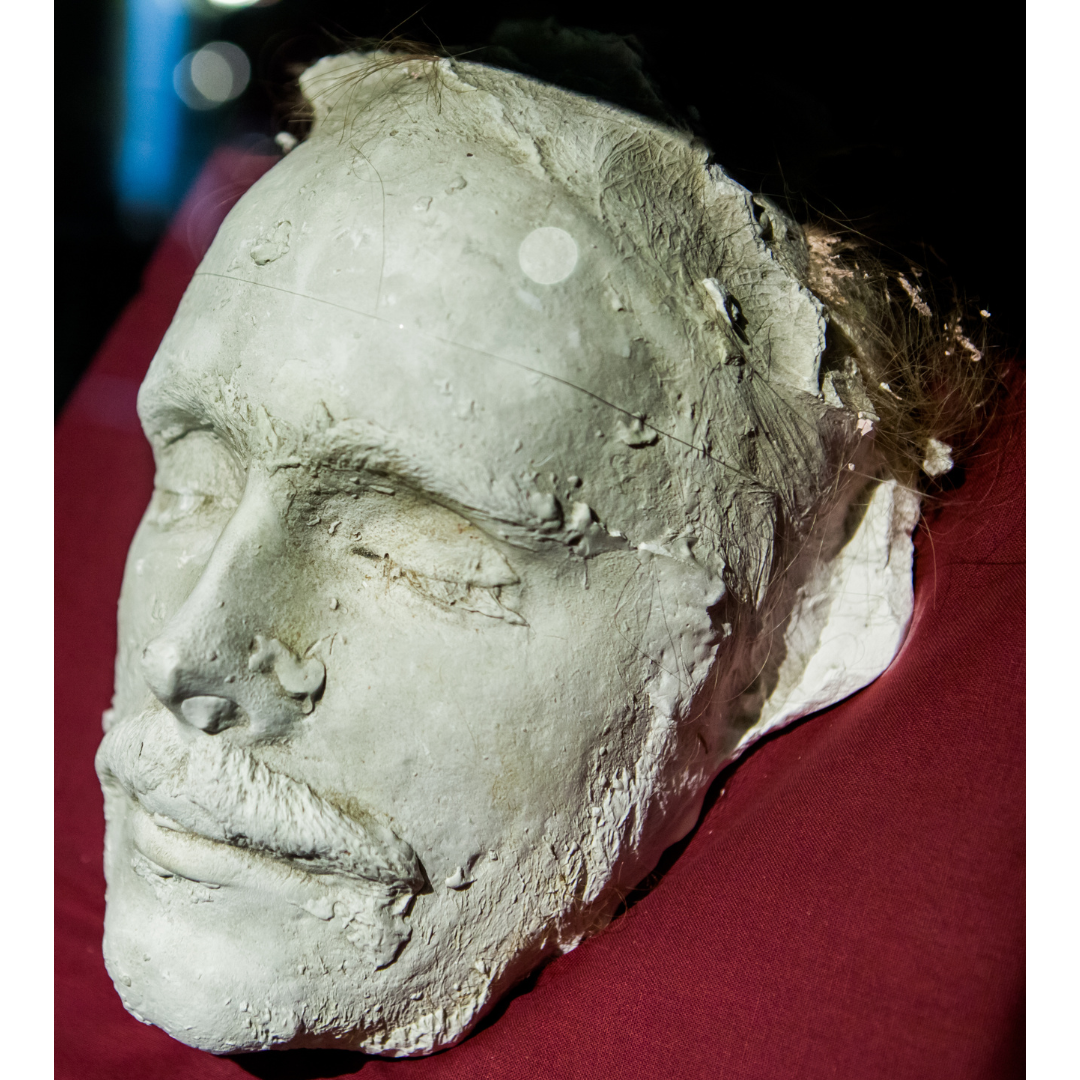The Essex Police Museum has many artefacts on display, dating from the 18th century to modern day. Most are quite normal and what you’d expect to find in a museum – historic relics, uniforms, old equipment etc., but being a police museum with crime displays, some artefacts are rather unsettling. This article takes a look at some of the artefacts most frequently called ‘creepy’ or ‘weird’ by our visitors.
Our first two artefacts come from the Moat Farm Murder, a case dating from 1899-1903.
The Moat Farm Murder: The Case
To better understand the artefacts it’s useful to know the case first.
Camille Holland, was murdered for her money in 1899 by her partner, Samuel Dougal. Rumours of Dougal’s part in Camille’s disappearance spread throughout the village, eventually reaching the village policemen, James Drew. PC Drew reported it to the Chief Constable, Captain Showers, and Superintendent Pryke, who was in charge of the area, was ordered to make enquiries. To assist Pryke, Captain Showers appointed Alfred Marden and he looked into Dougal’s financial affairs. Dougal was arrested on forgery charges after attempting to change some notes at the bank under a false name. When arrested, he was carrying a substantial sum of money and jewellery belonging to Camille Holland.
On 19th March Officers moved in to Moat Farm in an effort to trace Ms. Holland. In the house they found many items belonging to Camille, but no evidence that she had been there recently. Their attention turned to the garden. Throughout the following five weeks the search team dug, but found nothing. They even drained the ditch, but nothing was found. Eventually a local man informed the officers that Dougal had had another ditch filled in shortly after moving in and, after tracing the man hired to fill the ditch, police located it and begun digging. First a piece of cloth got snagged on a fork, then a ladies boot button was found revealing the boot and the human bones within it, then a body laying face down was revealed. The body had a bullet wound to the head, above the right ear.
DNA was still 100 years off, and the body had decomposed too much for a visual identification. Instead officers used items found with the body, clothing, jewellery and shoes, to confirm the body was that of Camille Holland. Mrs Henrietta Wiskin, Camille’s previous landlady, confirmed the clothing was Camille’s, but the real clincher was the shoes. Despite the shoes having been buried in an old drainage ditch for four years the makers stamp was still visible, so officers took them to Mr Mold. Due to Camille’s uniquely small shoe size, 2.5, Mr Mold was able to confirm that he made them for Camille Holland.
A Coroner’s inquest was held and, after three days of deliberation with multiple witnesses, the jury declared that the remains were those of Camille Holland, and that she had died from a single bullet wound to the head on 19th May 1899. As the bullet removed from the head was similar to ammunition owned by Dougal the inquest implicated him in the killing. Samuel Herbert Dougal was charged with wilful murder and was held in custody until the next Assizes.
The trial was expected to last one week, but only took a day; the verdict hinged on whether the body found in the ditch at Moat Farm was Camille, and much of the evidence had already been shown at the coroner’s inquest. Plus, there were no witnesses for the defence despite Dougal’s ‘not guilty’ plea. The judge instructed the jury to consider (1) if that was not the body of Miss Holland, where was her body, and whose body was it? and (2) to only use evidence presented in court to reach their decision. The jury retired at 4pm and in under an hour announced their verdict – Dougal was guilty. The judge sentenced him to death by hanging.
Dougal appealed the conviction to the Home Secretary, this time admitting to killing her but stating it was accidental after his firearm “exploded”. According to Dougal he then went to rouse her, believing Camille had fainted from the shock, but when he couldn’t revive her he panicked and put her in the ditch covered by branches. The appeal was unsuccessful and Dougal was executed on 14th July 1903.
Artefact: Jack, Camille Holland’s Dog
Jack was a very loyal dog, and a much beloved pet. He even won over the police officers who moved into Moat Farm as part of their investigations.
When Camille died Jack went to live with Mrs Wiskens, Camille’s landlady. He eventually died of natural causes and was stuffed to preserve him forever, apparently placed on the parlour side table where Camille used to sit.
Many of our visitors find this weird, possibly as it’s unusual to encounter taxidermy nowadays. However, taxidermy is an art, and specimens can be used as educational resources in museums or research facilities, as a memorial like in the case of Jack, or for décor – you might have seen mounted deer heads or animal skin rugs, especially in old country houses. Back in Jack’s time it was actually a fairly common practise to honour pets if you could afford it.
Artefact: Camille Holland’s Shoes
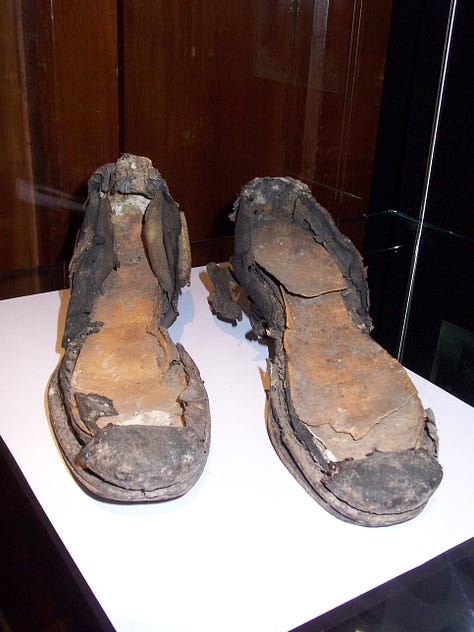
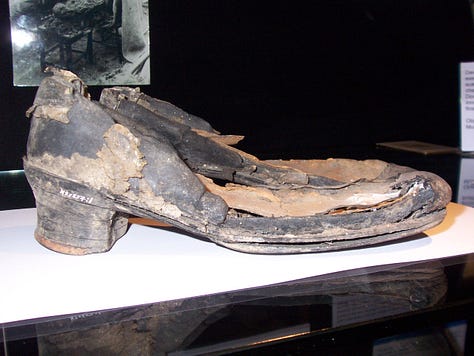
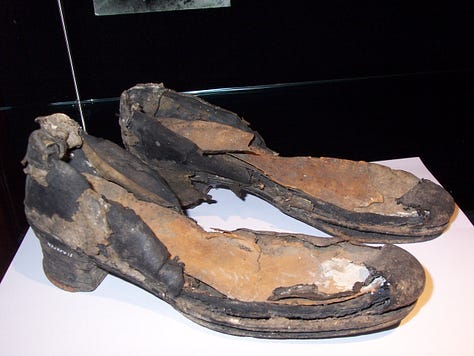

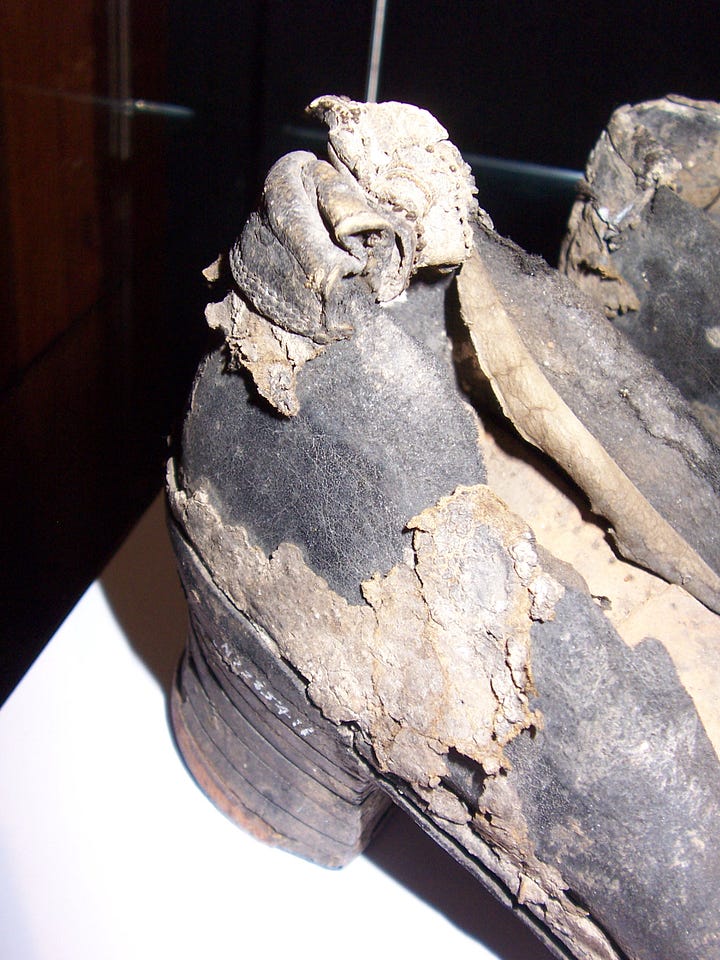
Despite their poor condition, Camille’s shoes were crucial in the identification of her body, and thereby vital in Dougal’s trial. You may ask what could be so creepy about a pair of shoes? Well, the shoes were on the body at the time it was discovered and had been buried with it for four years. Even today with all the true crime TV shows, podcasts and blogs it’s extremely rare to be so close to real evidence, especially evidence that has been in contact with a dead body. Our visitors say it’s not necessarily the shoes, it’s the story they tell and the fact that they’re real-life evidence that makes them so creepy.
Our last artefact is from The Murder of PC Gutteridge in 1927. George William Gutteridge began his police career on 5th April 1910, with a career break from May 1918 to February 1919 to serve in the army.
The Murder of PC Gutteridge: The Case
Shortly before 6am on 27th September 1927, Bill Ward, a motor engineer was driving from Romford to Abridge, delivering mail. As he approached Howe Green, he saw the huddled figure of a man at the side of the road with his legs sticking out into the road. Stopping his vehicle Ward recognised the body of PC George Gutteridge, the village constable from Stapleford Abbotts. His helmet lay near him, as did a pocket-book. A pencil was still gripped in his right hand. His truncheon was in its place at his side; his torch was in a pocket. His whistle hung loose. There was no sign that a struggle had taken place. Nearby however there were marks thought to be caused by a vehicle that had stuck the bank.
Ward ran up the road to Rose Cottage where he told Alfred Perritt of his discovery and while Perritt guarded the body, Ward drove on to Stapleford Tawney, from where he telephoned the police at Romford. By 8am Detective Inspector Crockford was at the scene and saw that PC Gutteridge had been shot in the face. Dr Robert Woodhouse from Romford was called out to the scene and from his observations thought that the officer had been dead for four or five hours. The body was removed to the nearby Royal Oak Public House and the following morning to Romford mortuary, where Dr Woodhouse carried out a post-mortem examination. He found that PC Gutteridge had been shot four times at close range, twice through the left cheek, and once in each eye. Two .45 bullets were prized out of the road surface at the scene and during the post-mortem a further bullet was recovered. These were to provide vital pieces of evidence.
The events leading to the murder were pieced together. PC Gutteridge had been the village constable at Stapleford Abbotts since 1924 and lived there with his wife and two children. On the night of 26th September 1927 he had been on patrol, covering his beat on foot. As was his custom, he had made a conference point with PC Sidney Taylor, the neighbouring village constable at 3am outside Grove House, Howe Green. The two men stood chatting until 3.25am, when they parted, Gutteridge setting off homewards. Gutteridge had only walked a few hundred yards before meeting his death.
To understand the motive for Gutteridge’s murder we first need to take a look at another crime.
Some 10 miles away police at Billericay had been alerted to the theft of a Morris Cowley motor car belonging to Dr. Edward Lovell from his garage in London Road. Some of his medical instruments and some drugs were in the car. But by the time the theft was reported, the car had already been found abandoned some 37 miles away in a narrow passage in Brixton on his way to work. On his return after work seeing the car still there he reported his discovery to the Metropolitan Police. When the vehicle was examined a spent cartridge shell, marked RLIV, was found on the floor on the passenger side of the vehicle. There were also blood splashed near the steering wheel, and the front nearside wing was damaged.
Dr Lovell was in the habit of noting down his daily mileage, and armed with this information the police drove the car from Brixton to the scene of the murder and then on to Billericay. The distance, 43 miles, matched the difference between Dr Lovell’s last use and the mileage on the abandoned car. It looked as if the murder was linked to the theft of the car. The Chief Constable, Captain Unett, asked for the assistance of the Metropolitan Police who sent one of their most experienced detective, Chief Inspector James Berrett to oversee the enquiry. However there were no developments for four months, despite hundreds of policemen working on the case. The horrific details of the crime were featured in the newspapers and rewards were offered for information leading to an arrest.
The cartridge case found in the car had markings on it which indicated that it was an old Mark IV type made at the Royal Laboratory in Woolwich Arsenal for troops in the First World War. The bullets and the cartridge case were handed to the ballistics expert Robert Churchill for examination. Although deformed, the bullets retained sufficient rifling characteristics for Churchill to establish they had been fired from a Webley revolver.
The Suspects
Frederick Guy Browne, alias Leo Brown
Frederick Guy Browne, a mechanic, was described as a man who was easily provoked to anger. He had been in and out of jail since the age of 29 and his first conviction was in 1910 for carrying firearms. In February 1924 he was sentenced at the Old Bailey to four years penal servitude. Browne was sent to Parkhurst prison but was moved to Dartmoor due to violent behaviour.
Upon release he rented premises in Lavender Hill and turned it into a garage/repair-yard. There was a primitive office at the back in which there was a bed. Here slept a man employed to keep the books and do odd jobs, of whom Browne said “I got him from the Salvation Army to give him a start.” This was forty-two-year-old Pat Kennedy. It’s likely the two men met in Dartmoor prison.
William (Pat) Kennedy
Kennedy’s name was either Patrick (Pat) Michael Kennedy or William Henry Kennedy.
Trained as a compositor, he worked mainly in Liverpool, where in 1911 his first conviction for indecent exposure earned him two months’ hard labour. Following a spell in the Army other fines and convictions soon followed, for theft, being drunk and disorderly, loitering, housebreaking and larceny. For this last offence he was sentenced to three years’ penal servitude. On his release in April 1916 he enlisted in the Hussars, deserted, enlisted in the King’s Liverpool Regiment, deserted, rejoined the King’s under a different name and was discharged with ignominy. His criminal career continued and from 1920 to 1927 he was hardly out of prison.
The Arrest
Browne continued with his life of crime and robbing railway station offices became his speciality. He stole a Vauxhall car which was sold a few days later in Sheffield, to a Benjamin Stow, who parted with £100 and a Angus-Sanderson car, CW 3291, in part exchange. In January 1928 the car was involved in a non-stop accident in Sheffield and as a result of police enquiries Frederick Guy Browne was named.
The police had the evidence they needed and obtained a search warrant to search the garage. As Browne returned to the premises, driving the Angus Sanderson, the police moved in and arrested him. A search revealed a Webley revolver, (which would later be shown to have fired at least one of the fatal shots); a quantity of ammunition, a stockinette mask and a number of medical items which Dr Lovell would identify as his property. A further search of the car revealed another fully loaded Webley revolver in a secret recess behind the driver’s seat. In Browne’s home police recovered more medical items, a small nickel-plated revolver and a fully loaded Smith and Wesson revolver and a quantity of ammunition.
Kennedy, ignorant of Browne’s arrest, visited the garage, but finding it locked and two men who he thought were detectives inside, he hurried back to his wife. The pair travelled to Liverpool on the midnight train from Euston.
On Wednesday the 25th Kennedy was arrested. That night he was spotted by Sergeant Bill Mattinson of the Liverpool City Police, who knew Kennedy of old. He approached Kennedy from behind and said: “Come on, Bill.”
Kennedy stopped dead in his tracks, spun around. Recognising the policeman, he said: “Stand back, Bill or I’ll shoot you!” Kennedy produced a gun, thrust its muzzle into the officer’s ribs and squeezed the trigger. There was a click and Mattinson wrenched the pistol from Kennedy’s grasp. Shouting for assistance Kennedy was taken into custody. Fortunately, the safety catch was found to be on, but Mattinson, realizing how close he had been to being shot, collapsed.
Taken to Warren Street Police Station, Kennedy was charged with being concerned with Browne in stealing a Vauxhall motor car. He said to Mattinson: “I’m sorry. I’ve no grudge against the police, but you should be in heaven now.”
Kennedy’s Statement and Two Charged
Kennedy was taken to London where he was interviewed by Berrett. Asked if he had any information to give about the murder of PC Gutteridge, Kennedy asked to be allowed to think, and did so for several minutes. “Can I see my wife?” he asked. Mrs Kennedy was fetched.
Kennedy said: “Well, my dear these officers are making enquiries about that policeman murdered in Essex.” She exclaimed “Why you didn’t murder him, did you?” “No,” he replied “I didn’t, but I was there, and know who did. If I’m charged with murder and found guilty I shall be hanged, and you will be a widow. If I’m charged and found guilty of being an accessory I shall receive a long sentence and be a long time away from you. Will you wait for me?” She replied, “Tell these gentlemen the truth of what took place,” Kennedy then told Berrett, “You can take down what I want to say and I will sign it.”
It took him over three hours to dictate his statement. In it he said that he and Browne had gone to Billericay to steal a motor-car. As they were driving back to London via Stapleford Abbotts they were stopped and questioned by PC Gutteridge. It was then Kennedy alleged that Browne shot the officer four times. After the shooting Browne had handed the gun back to Kennedy and told him to reload it. They continued their journey to Brixton where they abandoned the car, taking the medical instruments with them.
Questioned about the murder, Browne could make no counter-allegations, as his defence was that he was never in Essex that night. He claimed he was in bed with his wife. Both men were charged with the murder of PC Gutteridge. “It’s absurd,” said Browne. “I know nothing about it.”
The Trial
Both men were charged with murder. Their trial began at the Old Bailey on Monday; 23 April before Mr Justice Avory. The Solicitor- General, Sir Boyd Merriman, led for the Crown. Over the five days of the trial over 40 prosecution witnesses gave evidence.
The ballistics evidence, concerning the bullets, the cartridges, and the gun-prints made by the breech of the Webley, was damning, the first time such evidence had been used to such effect in a murder trial. Four firearms experts were called, including Robert Churchill, the Crown’s chief expert, who testified at great length, demonstrating in detail how the Webley found in Browne’s possession when he was arrested was matched to the cartridge and bullets that killed PC Gutteridge.
The Jury took two hours to return a verdict of guilty against both men. A subsequent appeal was dismissed and on the 31st May, Browne, maintaining his innocence to the end was hanged at Pentonville prison whilst Kennedy suffered the same fate at Wandsworth prison.
PC Gutteridge is buried in Warley Cemetery, Brentwood and a memorial indicates the spot where he was murdered.
Artefact: The Death Mask
Death masks are plaster or wax copies of a person’s face made after the person died. Typically, death masks would be used as mementos or for portraits, but they can also be used for research and analysis. It’s unclear why a death mask for Frederick Browne would’ve been made, though some theories speculate it’s due to the case’s notoriety. Although death masks are relatively common artefacts – there’s many in collections across the world – it’s relatively unusual to see them, especially up close. Visitors say our death mask is creepy because the plaster is ghostly white, others mention the realism of the face, saying it appears the eyes will open at any moment, but almost all say the creepiest thing is the real hair that got stuck in the plaster when the mask was made.

